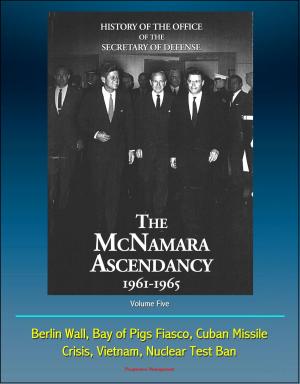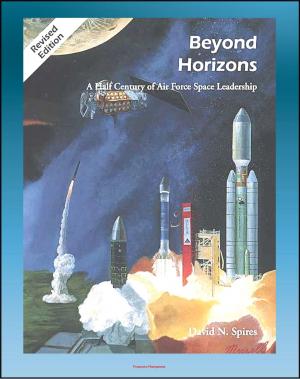The Office of the Secretary of the Air Force 1947-1965: World War II, Symington, Berlin Airlift, Battle over B-36, Korean War, Scientist Secretary, Missiles, Air Force Academy, ARPA, NASA, B-70
Nonfiction, History, Asian, Korean War, Military, Aviation| Author: | Progressive Management | ISBN: | 9781311323576 |
| Publisher: | Progressive Management | Publication: | April 12, 2015 |
| Imprint: | Smashwords Edition | Language: | English |
| Author: | Progressive Management |
| ISBN: | 9781311323576 |
| Publisher: | Progressive Management |
| Publication: | April 12, 2015 |
| Imprint: | Smashwords Edition |
| Language: | English |
Professionally converted for accurate flowing-text e-book format reproduction, this USAF history book follows the development of the Office of the Secretary of the Air Force from its predecessor organization —the Assistant Secretary of War for Air during World War II —to its modern identity as one of three service secretariats within the Department of Defense. Watson vividly describes the influence of several Air Secretaries: Robert A. Lovett, W. Stuart Symington, Harold E. Talbott, and Eugene M. Zuckert. Each made a personal contribution in defining and answering the military issues of the day, among them, the independence of the Air Force, the war in Korea, arguments over roles and missions, and nuclear strategy. This work traces the history of the Office of the Secretary of the Air Force from its formation in the 1920s (as the Office of the Assistant Secretary of War for Air) through World War II, under Robert A. Lovett. It concentrates on the period from 1947, when the Air Force became independent of the Army, to 1965, when the United States became involved in the Vietnam War. During this time several laws significantly reshaped the U.S. military establishment: the National Security Act of 1947, its amendments of 1949, Reorganization Plan No. 6 of 1953, and the Department of Defense Reorganization Act of 1958. These laws gradually strengthened the Department of Defense and firmly established civilian control over the military services.
Author George Watson details how these laws affected the functioning of the first seven Secretaries of the Air Force, from W. Stuart Symington to Eugene M. Zuckert. The Air Force and its Secretaries struggled over autonomy, roles, and missions; fought the Korean War and the Cold War; procured advanced aircraft, missiles, and other weapons; and wrestled with many issues involving budgets, force size and structure, racial integration, morale, and congressional and public relations. The Secretaries of the Air Force have each brought unique leadership styles to office. This study provides a context for understanding the complex changes that confronted them as the United States successively moved through the jet, atomic, and space ages. It should prove useful to both civilian and military Air Force policy makers as they operate in a new era in which America's air power has become truly global and unprecedented in influence and reach.
Chapter 1 - Precedent for an Air Secretary * The Roots of the Office * The Air Arm Expands * The Air War Ensues * A Multitude of Concerns * War Issues * The War Ends * Lovett's Legacy * Chapter 2 - The Interlude (1946-1947) * The Office of the Assistant Secretary of War for Air * Symington Takes Over * Manpower * Cost Control * Independence * Chapter 3 - Separate and Equal: The First Secretariat * The Office of the Secretary of the Air Force * Controversies * Symington Exerts His Charm * Building the New Air Force * Unification * Roles and Missions * The Berlin Airlift * Chapter 4 - The Battle over the B-36 * Chapter 5 - The Finletter Era (1950-1953) * Finletter's Team * Finletter's Relationship with the Air Staff * The Press and Public Relations * The Deputy System * Procurement Difficulties * The Effects of the Korean War * Force Structure * Other Issues * The Air Force Organization Act of 1951 * Logistical Control * Summary * Chapter 6 - Talbott and Quarles (1953-1957) * New People under the New Look * Talbott's Turn * The Scientist Secretary * Quarles and Missiles * A Divergence of Views * Chapter 7 - The Air Staff and the OSAF * Chapter 8 - Douglas and Sharp (1957-1961) * Douglas Takes Charge * Weathering Cuts * A Change of Mood * Douglas and the Air Force Academy * Douglas, ARPA, and NASA
Professionally converted for accurate flowing-text e-book format reproduction, this USAF history book follows the development of the Office of the Secretary of the Air Force from its predecessor organization —the Assistant Secretary of War for Air during World War II —to its modern identity as one of three service secretariats within the Department of Defense. Watson vividly describes the influence of several Air Secretaries: Robert A. Lovett, W. Stuart Symington, Harold E. Talbott, and Eugene M. Zuckert. Each made a personal contribution in defining and answering the military issues of the day, among them, the independence of the Air Force, the war in Korea, arguments over roles and missions, and nuclear strategy. This work traces the history of the Office of the Secretary of the Air Force from its formation in the 1920s (as the Office of the Assistant Secretary of War for Air) through World War II, under Robert A. Lovett. It concentrates on the period from 1947, when the Air Force became independent of the Army, to 1965, when the United States became involved in the Vietnam War. During this time several laws significantly reshaped the U.S. military establishment: the National Security Act of 1947, its amendments of 1949, Reorganization Plan No. 6 of 1953, and the Department of Defense Reorganization Act of 1958. These laws gradually strengthened the Department of Defense and firmly established civilian control over the military services.
Author George Watson details how these laws affected the functioning of the first seven Secretaries of the Air Force, from W. Stuart Symington to Eugene M. Zuckert. The Air Force and its Secretaries struggled over autonomy, roles, and missions; fought the Korean War and the Cold War; procured advanced aircraft, missiles, and other weapons; and wrestled with many issues involving budgets, force size and structure, racial integration, morale, and congressional and public relations. The Secretaries of the Air Force have each brought unique leadership styles to office. This study provides a context for understanding the complex changes that confronted them as the United States successively moved through the jet, atomic, and space ages. It should prove useful to both civilian and military Air Force policy makers as they operate in a new era in which America's air power has become truly global and unprecedented in influence and reach.
Chapter 1 - Precedent for an Air Secretary * The Roots of the Office * The Air Arm Expands * The Air War Ensues * A Multitude of Concerns * War Issues * The War Ends * Lovett's Legacy * Chapter 2 - The Interlude (1946-1947) * The Office of the Assistant Secretary of War for Air * Symington Takes Over * Manpower * Cost Control * Independence * Chapter 3 - Separate and Equal: The First Secretariat * The Office of the Secretary of the Air Force * Controversies * Symington Exerts His Charm * Building the New Air Force * Unification * Roles and Missions * The Berlin Airlift * Chapter 4 - The Battle over the B-36 * Chapter 5 - The Finletter Era (1950-1953) * Finletter's Team * Finletter's Relationship with the Air Staff * The Press and Public Relations * The Deputy System * Procurement Difficulties * The Effects of the Korean War * Force Structure * Other Issues * The Air Force Organization Act of 1951 * Logistical Control * Summary * Chapter 6 - Talbott and Quarles (1953-1957) * New People under the New Look * Talbott's Turn * The Scientist Secretary * Quarles and Missiles * A Divergence of Views * Chapter 7 - The Air Staff and the OSAF * Chapter 8 - Douglas and Sharp (1957-1961) * Douglas Takes Charge * Weathering Cuts * A Change of Mood * Douglas and the Air Force Academy * Douglas, ARPA, and NASA















